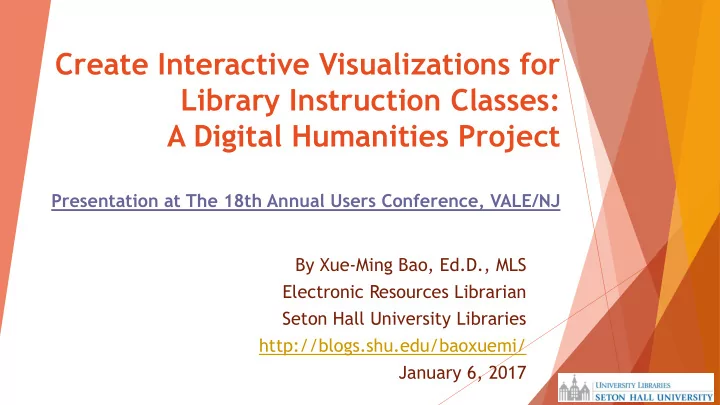

Create Interactive Visualizations for Library Instruction Classes: A Digital Humanities Project Presentation at The 18th Annual Users Conference, VALE/NJ By Xue-Ming Bao, Ed.D., MLS Electronic Resources Librarian Seton Hall University Libraries http://blogs.shu.edu/baoxuemi/ January 6, 2017
Outline Project Objective and Questions Literature Review Visualization Tools Visualization Examples Demo of Using Power BI
Project Objective and Questions To explore the best ways of visualizing library databases to improve library instructions. Questions: What databases does the library offer? What does a library database include? How to answer the two questions in an engaging, interesting, and meaningful way?
Literature Review (1) Lack of student interest and engagement was an issue of student-related challenges, Lack of time allocated for lesson preparation or time for providing sessions themselves was an issue of instructor-related challenges. Source: Julien, Heidi, Maria Tan, and Shannon Merillat. 2013. “Instruction for Information Literacy in Canadian Academic Libraries: A Longitudinal Analysis of Aims, Methods, and Success.” Canadian Journal of Information and Library Science 37 (2): 81 – 102.
Literature Review (2) “ The relationships among the frequently cited authors, references, journals and keywords can be explained visually .” Source: Feng et al. 2015. “Visualization and Quantitative Study in Bibliographic Databases: A Case in the Field of University – Industry Cooperation .” Journal of Informetrics 9: 118-134.
Literature Review (3) Visualizations of library data have been used to: Reveal relationships among subject areas for users Illuminate circulation patterns Suggest titles for weeding Analyze citations and map scholarly communications. Source: Finch, Jannette L. and Angela R. Flenner. 2016. “Using Data Visualization to Examine an Academic Library Collection .” College & Research Libraries 77, no. 6 (November): 765-778. Accessed December 20, 2016. http://crl.acrl.org/content/77/6/765.full.pdf+html.
Literature Review (4) “Digital humanists have long argued that digital projects, such as databases, visualization, and digital scholarly editions, are rigorous and theoretical forms of humanities scholarship that require different methods of evaluation and dissemination .” Source: Coble, Zach, Sarah Potvin, and Roxanne Shirazi. 2014. "Process as Product: Scholarly Communication Experiments in the Digital Humanities." Journal of Librarianship and Scholarly Communication 2 (3): eP1137|5. Accessed June 10, 2016. http://dx.doi.org/10.7710/2162-3309.1137.
Visualization Tools Directory of data visualization tools sponsored by the Andrew W. Mellon Foundation http://dirtdirectory.org/tadirah/visualization Microsoft Power BI https://powerbi.microsoft.com/ Tableau Public https://public.tableau.com/s/gallery The R Project for Statistical Computing https://www.r-project.org/
Power BI Visualizations Bring up Power BI Desktop for a Demo Stacked bar chart, Stacked column chart, Clustered bar chart, Clustered column chart, 100% stacked bar chart, 100% stacked column chart, Line chart, Area chart, Stacked area chart, Line and stacked column chart, Line and clustered column chart, Waterfall chart, Scatter chart, Pie chart, Treemap, Map, Table, Matrix, Filled map, Funnel, Gauge, Multi-row chart, Card, Slicer, Donut chart, BrushChart, Histogram, LongTextViewer, SupperBubbles, TableHeatMap, TableSorter, TimeBrush, TimeLine, WordCloud, GlobeMap
Visualization Examples (1) Visualization Examples of Library Resources A Quick Glance of Library Databases (Pie chart, Super Bubbles, and Table) Keywords from SHU Theses and Dissertations (Word Cloud) History Electronic Resources (Slicer, ChicletSlicer, and Table)
Visualization Examples (2) The Status of Dr. John C. H. Wu’s Works Collected by Worldwide Libraries Publishers of John C. H. Wu's Works Citations of The Golden Age of Zen (1967) John C. H. Wu’s Chinese Name ( 吴经熊 ) in Scholarly Article Titles John C. H. Wu’s Chinese Name ( 吴经熊 ) in References of Scholarly Articles
Conclusions The benefit and challenge of visualizing library’s bibliographic information: Interactive visualizations allow a user to see deeper layer of the data by clicking on one field to view the change in another. Interactive visualizations seem to be helpful in the study of a well-known author. Experiments are needed to explore the best and meaningful ways of visualizing bibliographic data to make library instructions interesting.
Demo of Using Power BI Power BI https://powerbi.microsoft.com/
Recommend
More recommend